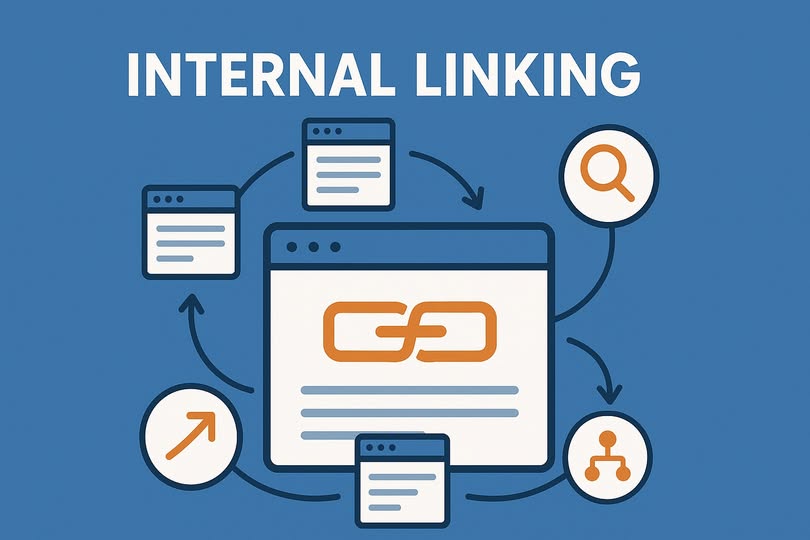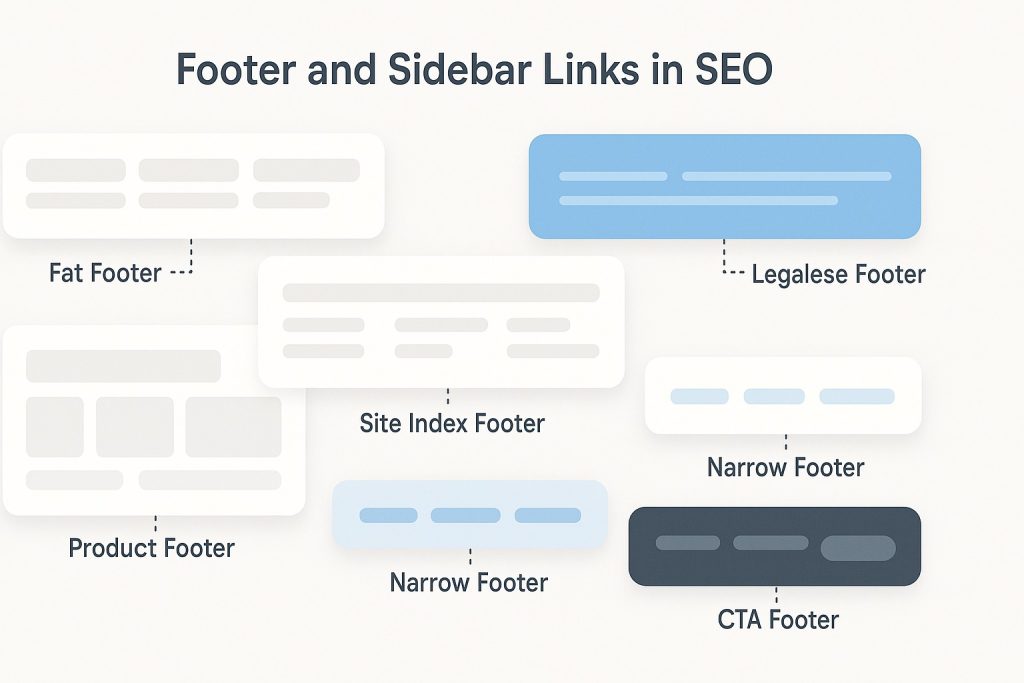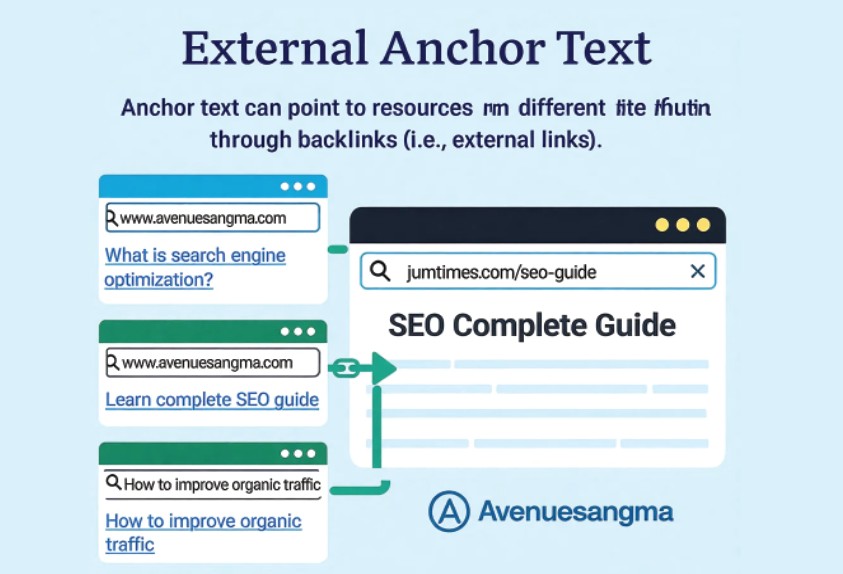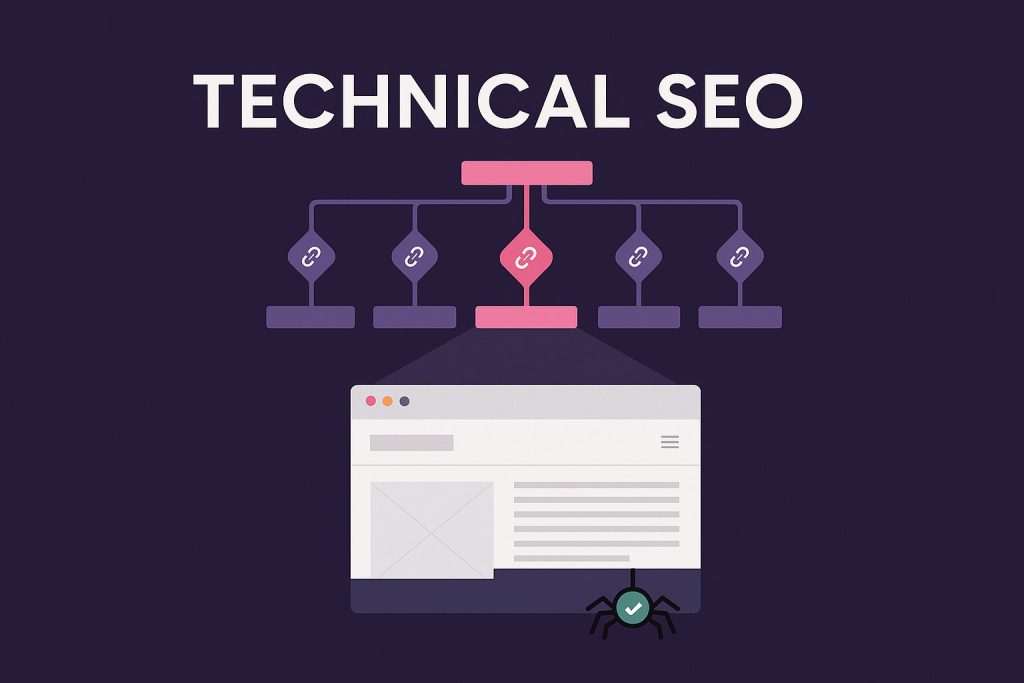Every successful website is built on a strong internal structure, one that guides both users and search engines effortlessly from one page to another. This invisible framework is known as internal linking, and it’s far more than just adding hyperlinks between pages.
Internal linking is the practice of connecting one page of your website to another through contextual hyperlinks. These links strengthen your overall website structure, distribute link equity (PageRank), and improve both user experience and search visibility.

A solid internal link strategy is a core part of On-Site SEO helping Google understand your site’s hierarchy, content relationships, and keyword relevance. Think of it as the roadmap that allows both humans and crawlers to discover valuable content efficiently.
When done right, internal linking not only enhances SEO performance but also boosts organic traffic by ensuring your most important pages gain more visibility. For practical ways to grow your search traffic through strategic link placement and optimization, explore to Increase Organic Traffic — a perfect complement to this guide.
Why Internal Linking Matters for SEO
Internal linking does more than connect pages, it builds your site’s authority from the inside out. Here’s why it’s so critical:
- Improves crawlability: Search engines use internal links to discover new content. The easier it is to crawl, the faster your pages get indexed.
- Distributes link equity: Internal links share “ranking power” from high-authority pages to those that need a boost.
- Enhances user navigation: Visitors can move smoothly through your site, finding related content easily.
- Supports topic clusters: It organizes your content into logical groups, strengthening topical relevance and E-E-A-T (Experience, Expertise, Authoritativeness, Trustworthiness).
In essence, internal linking is the glue that keeps your website architecture strong, your visitors engaged, and your SEO performance scalable.
Types of Internal Links and Their SEO Benefits
Not all internal links are created equal. Understanding their types helps you apply them strategically for maximum impact.
1. Navigational Links
These are the links that appear in your website’s main menu, header, or footer. They help users reach key sections (like Home, Blog, Services, or Contact) quickly.

SEO Benefit:
Navigational links define your website’s overall hierarchy and help distribute link equity evenly across your top-level pages.
2. Contextual Links
Contextual links are placed naturally within the body of your content — for example, linking a blog post about SEO strategy to another about keyword research.

SEO Benefit:
They are the most powerful type of internal link because they provide context to both users and search engines. By linking related topics, you signal content relationships and keyword relevance.
3. Footer and Sidebar Links
These links appear at the bottom or side of a webpage, often highlighting popular posts, related articles, or category pages.

Example image of different footer’s
Footer Links Example #1: Forbes
This image showcases the footer section of the Forbes website, which is designed with a sleek black background and clear typographic hierarchy. The section is divided into three primary columns, each serving a distinct informational purpose:

SEO Benefit:
They help users discover additional resources and extend session duration — improving engagement metrics like dwell time and pages per session.
Real-World Example:
Major brands like HubSpot and Ahrefs strategically interlink blog articles with pillar pages to improve topical authority. When users read about “SEO basics,” they’re guided to deeper topics like “technical SEO” or “content optimization,” creating a seamless experience that search engines love.
Anchor Text Optimization: Giving Context to Your Links
An internal link is only as powerful as its anchor text — the clickable words users see. Anchor text helps Google interpret what the linked page is about.

To maximize SEO impact:
- Use descriptive and keyword-rich anchors, not vague ones like “click here.”
- Keep the anchor text natural within the sentence flow.
- Avoid over-optimization by using varied anchor phrases (exact match, partial match, branded, and generic).

Anchor text acts as a ranking signal. When multiple pages link to a target page using relevant keywords, that page is more likely to rank for those terms.
To dive deeper into professional anchor text techniques, variations, and best-practice ratios, explore Anchor Text in SEO a practical guide that complements your internal linking strategy perfectly.
Technical SEO and Internal Linking: The Structural Connection
A great internal linking plan doesn’t stand alone — it depends on solid technical SEO foundations.
Technical SEO ensures your internal links are crawlable, indexable, and logically structured. Here’s how it all ties together:
- Site Architecture: Your website should follow a logical hierarchy — homepage → category → subcategory → article. This keeps link depth shallow (within 3 clicks) and ensures Google can reach every page.
- Crawl Budget: Each internal link consumes a portion of Google’s crawl budget. Efficient linking prevents wasting crawl capacity on duplicate or irrelevant pages.
- Broken Links: Dead or redirected internal links hurt both UX and crawl efficiency. Regular audits keep them clean.
- Orphan Pages: Pages without internal links are practically invisible to search engines. Linking them strategically revives their visibility.
Tools like Google Search Console, Ahrefs Site Audit, or Screaming Frog SEO Spider help you analyze internal link flow, identify crawl issues, and maintain healthy linking structures.
For a deeper understanding of how your website’s technical foundation shapes link effectiveness, read Technical SEO — it explains the core mechanics that power a seamless internal linking ecosystem.
Building an Effective Internal Linking Strategy: Step-by-Step Framework
Creating a high-impact internal linking plan is all about maintaining structure and consistency throughout your strategy. A well-organized approach ensures that your links not only improve navigation but also enhance the user experience and boost SEO.
To get it right, follow this straightforward framework, which lays the foundation for an effective and cohesive internal linking strategy.
Step 1: Map Your Content for a Smarter Linking Strategy
Content mapping is the process of organizing your site’s content to create a logical structure for internal linking. It involves visualizing how your pages relate to one another, identifying core topics, and planning how to connect them. Think of it as creating a blueprint for your website.
Without a map, your internal linking efforts can become chaotic, leaving valuable pages isolated and making it difficult for visitors to find the information they need.
A well-mapped content structure is fundamental for both SEO and user experience. For SEO, it helps distribute page authority (or “link equity”) throughout your site, signaling to search engines which pages are most important. It also allows search engine crawlers to discover and index all your content efficiently.
For users, a logical map creates intuitive navigation pathways, guiding them from broad topics to more specific details, which improves engagement and reduces bounce rates.
Creating a content map involves a few strategic steps that transform your collection of pages into a cohesive ecosystem.
Step 1: Conduct a Content Audit
Before you can create a map, you need to know what you have. A content audit is the process of cataloging all the existing content on your website. Create a spreadsheet and list all your important URLs, along with their primary topic or keyword, content type (blog post, service page, etc.), and current performance metrics if available. This inventory gives you a complete overview of your assets.
Step 2: Identify Pillar and Cluster Pages
Your content map will be built around a “topic cluster” model. This model consists of two main components:
- Pillar Pages: These are broad, comprehensive guides on a core topic central to your business. For example, a digital marketing agency might have a pillar page on “Social Media Marketing.” This page covers all aspects of the topic at a high level.
- Cluster Pages: These are more detailed articles that explore specific subtopics related to the pillar page. For the “Social Media Marketing” pillar, cluster pages could include “Instagram Advertising Tips,” “Creating a Facebook Content Calendar,” or “LinkedIn for B2B Lead Generation.”
During your content audit, identify which existing pages can serve as pillars and which can be supporting clusters. You may also find gaps where new cluster or pillar content needs to be created.
Step 3: Create a Visual Map
With your pillar and cluster pages identified, it’s time to visualize the connections. You can use a simple spreadsheet, a mind-mapping tool, or even a whiteboard.
- Place your pillar page topic at the center.
- Arrange its related cluster pages around it.
- Draw lines from the pillar page to each cluster page and back. This represents the core internal links: the pillar should link to all its clusters, and each cluster should link back to the pillar.
- Identify opportunities to link cluster pages to each other where it makes sense contextually. For instance, your post on “Instagram Advertising Tips” might logically link to “Creating Engaging Instagram Reels.”
By mapping your content this way, you create a strategic plan for internal linking. Instead of randomly adding links, you can refer to your map to build a powerful, organized site structure that boosts your SEO and provides a seamless journey for your audience.
This not only helps establish your website as a reliable source of information, but it also encourages readers to explore related topics on your site.
Step 2: Identify Pillar and Cluster Pages
At the heart of a powerful internal linking strategy is the “topic cluster” model, which organizes your content around central themes. This model consists of two key components: pillar pages and cluster pages. Understanding their roles is crucial for creating a logical site structure that benefits both users and search engines.
A pillar page acts as a central hub for a broad topic, while cluster pages are more detailed articles that explore specific subtopics related to that pillar.

Example of Identify Pillar and Cluster Pages
This structure transforms your website from a random collection of articles into an organized library of information. For SEO, it signals to search engines that you are an authority on the pillar topic, as you cover it comprehensively through linked, in-depth content. For users, it creates a clear path to explore a subject, allowing them to start with a general overview and dive into the specifics that interest them most, which improves engagement and time on site.
What Are Pillar and Cluster Pages?
- Pillar Page: This is a comprehensive, high-level guide on a core topic that is central to your business. It aims to cover every aspect of the topic broadly. For instance, a software company might have a pillar page on “Customer Relationship Management (CRM).” This page would touch on CRM benefits, features, implementation, and strategies, but it wouldn’t go into exhaustive detail on any single point. It serves as the main hub.
- Cluster Pages: These are individual, detailed articles that focus on one specific subtopic mentioned on the pillar page. Each cluster page links back to the pillar page, reinforcing its authority. Following the CRM example, cluster pages could be:
- “How to Choose the Right CRM for a Small Business”
- “Integrating a CRM with Your Email Marketing”
- “5 Ways to Improve Sales with a CRM”
Together, they create a tightly-knit web of content where the pillar links out to each cluster, and every cluster links back to the pillar.
How to Identify Your Pillar and Cluster Content
Use these steps to find existing pages that can fit into this model or to identify gaps for new content creation.
Evaluate Content Depth: A true pillar page should be substantial but not overly detailed on any one point. If you have an extremely long article that dives deep into multiple subtopics, consider breaking it up. The main article can be edited to become the pillar page, and the detailed sections can be spun off into their own cluster pages. Conversely, if you find a potential pillar page is too thin, you have a clear roadmap for what cluster content you need to create to support it.
Analyze Keyword Themes: Start by grouping your target keywords into broad topic categories. For example, if you have keywords like “content marketing strategy,” “blogging tips,” and “SEO content writing,” your overarching topic theme is “Content Marketing.” This broad theme is a prime candidate for a pillar page. The more specific keywords will guide your cluster page topics.
Conduct a Content Audit: Review your existing content with the topic cluster model in mind. Look for your longest, most comprehensive articles that cover a broad topic. These are your potential pillar pages. They are often your highest-performing assets that attract significant traffic. Then, identify shorter, more niche articles that could serve as cluster content supporting those pillars.
Step 3: The Power of Contextual Linking
Contextual linking is the practice of placing internal links within your content where the surrounding text directly relates to the topic of the linked page. It’s about creating a logical bridge from one piece of information to another. Instead of just dropping a link anywhere, you embed it within a sentence or paragraph that gives the reader and search engines a clear reason why that link is there.

The Power of Contextual Linking
This strategy is vital for both search engine optimization (SEO) and user engagement. For users, a contextual link provides a seamless path to explore a related topic in more detail, enriching their experience and keeping them on your site longer. For search engines, the text surrounding a link—the “semantic context”—helps them understand the relevance and value of the destination page, which can boost its authority and ranking potential.
How to Implement Contextual Links Effectively
The key is to ensure the link feels like a natural part of the conversation you are having with your reader. It should clarify, support, or expand upon the point you are making.
Good vs. Bad Contextual Linking Examples:
- Good: “To improve your website’s visibility, focus on a comprehensive [on-page SEO strategy], which includes optimizing titles, meta descriptions, and content.”
- Why it works: The link is surrounded by terms like “website’s visibility,” “optimizing titles,” and “content,” giving strong contextual clues that the destination page is about on-page SEO.
- Bad: “SEO is important for your business. We offer many services. Learn about our [on-page SEO strategy].”
- Why it’s bad: The link feels isolated. The surrounding sentences are generic and provide no specific context about what on-page SEO involves or why the reader should care at that moment.
Actionable Tips for Contextual Relevance
Use these tips to ensure your internal links are always contextually sound:
- Surround Links with Relevant Keywords: Place your link within sentences that naturally include keywords and concepts related to the linked page’s topic. This reinforces the connection for both users and search engines.
- Link to Deeper, More Specific Content: Use contextual links to guide readers from a general overview page (a “pillar” page) to a more detailed article (a “cluster” page). For example, a blog post about digital marketing could link to specific articles on email campaigns or social media advertising.
- Review the Flow: Read the sentence aloud with the link included. Does it sound natural? Does it add value at that point in the text? If the link feels forced or out of place, find a better, more relevant spot for it.
- Use the Right Anchor Text: While the surrounding text provides context, your anchor text should still be descriptive. The combination of strong anchor text and relevant surrounding content sends the clearest possible signal about the link’s purpose.
By mastering contextual linking, you create a more intuitive website structure. This not only helps search engines crawl and understand your content more effectively but also builds trust with your audience by consistently providing them with valuable, relevant information.
Step 4: The Art of Natural Link Placement
Placing internal links within your content should feel organic, not forced. Natural link placement means integrating links in a way that genuinely adds value for the reader and flows seamlessly with the text. The goal is to guide users to other relevant pages on your site without disrupting their reading experience. Think of it as a helpful suggestion from a knowledgeable friend, rather than a jarring advertisement.
This approach is crucial for both user experience (UX) and search engine optimization (SEO). When links appear in logical places, they help readers dive deeper into a topic, increasing their engagement and time spent on your site. For search engines, naturally placed links with descriptive anchor text provide valuable context, helping them understand your site’s structure and the relationship between different pages.
How to Achieve Natural Placement
Effective implementation comes down to context and relevance. Your links should appear where a reader would naturally want more information.
Good vs. Bad Placement Examples:
- Good: “When optimizing your content, it’s important to conduct thorough [keyword research for your industry] to understand what your audience is searching for.”
- Why it works: The link offers a logical next step for someone learning about content optimization. The anchor text is descriptive and relevant.
- Bad: “Keyword research is an important part of SEO. [Click here] to learn more.”
- Why it’s bad: The phrase “Click here” provides no context for the user or for search engines. It interrupts the sentence’s flow and feels generic.
Actionable Tips for Seamless Integration
Follow these tips to master natural link placement:
- Prioritize the Reader: Before adding a link, ask yourself: “Would a reader find this useful at this exact moment?” If the answer is no, it’s probably not a good fit.
- Use Descriptive Anchor Text: The clickable text should clearly indicate what the destination page is about. Avoid generic phrases like “read more” or “click here.” Instead of “Learn more about our services [here],” try “Explore our full range of [digital marketing services].”
- Link from Main Body Content: Links placed within the core paragraphs of your content carry more weight than those in footers or sidebars. They appear more editorial and are more likely to be clicked.
- Don’t Overdo It: Stuffing too many links into a single paragraph can make the text look cluttered and spammy. A good rule of thumb is to add links only when they provide significant value. Spread them out evenly throughout the article.
By focusing on natural placement, you create a better experience for your audience and send strong positive signals to search engines. It’s a simple shift in strategy that enhances the credibility and usability of your entire website.
Step 5: Fix and Maintain
Regularly audit your internal links to fix broken paths, remove redundant ones, and update outdated URLs.
Step 6: Prioritize Important Pages
Use Google Analytics to identify pages driving conversions or engagement. Strengthen their visibility by linking to them from high-traffic content pieces.
Internal Linking and Topic Authority
Internal linking plays a key role in establishing topic authority. When multiple related pages link to a central resource, it signals to Google that your site is a credible authority on that subject.
For instance, if several posts about SEO best practices link to your ultimate guide on “Search Engine Optimization,” it reinforces that page’s authority and ranking potential.
To understand how internal linking fits into the broader SEO system, review the guide of Search Engine Optimization — it connects all the dots between content, structure, and visibility.
Common Internal Linking Mistakes to Avoid
Even experienced marketers make errors that dilute link value. Here are pitfalls to steer clear of:
- Over-linking: Too many links per page confuse users and reduce SEO value.
- Irrelevant linking: Linking unrelated topics misleads both users and crawlers.
- Ignoring deep pages: Always distribute links beyond your homepage or category pages.
- Neglecting anchor diversity: Reusing the same anchor text repeatedly looks unnatural.
- No follow-up audits: Internal link structures evolve — review them quarterly.
On-Page Optimization Signals for Internal Links
To maximize SEO results, combine internal linking with other on-page elements:
- Add related posts or “Read next” sections to extend user journeys.
- Use breadcrumbs for clear navigation paths.
- Implement HTML sitemaps for structure transparency.
- Optimize meta titles and descriptions for linked pages to strengthen contextual signals.
Sample Meta Title Ideas:
- “Internal Linking in SEO: The Complete Guide to Boosting Rankings and User Experience”
- “How Internal Links Improve Crawlability and Build Topic Authority”
- “Step-by-Step Internal Linking Strategy for Better SEO Performance”
LSI Keywords:
internal linking strategy, on-site SEO optimization, link equity, crawl budget, anchor text, topic clusters, internal links for SEO, content interlinking.
Build the Web Within Your Website
Internal linking is more than an SEO tactic — it’s the foundation of website architecture and the bridge between content and visibility. A well-structured internal link strategy improves navigation, builds authority, distributes ranking power, and keeps visitors engaged longer.
Whether you’re managing a blog, e-commerce site, or corporate portal, internal linking determines how effectively search engines interpret your content relationships.
Take the next step by auditing your internal link profile today. Identify your key pillar pages, connect them naturally, and strengthen your site’s structure from within.

